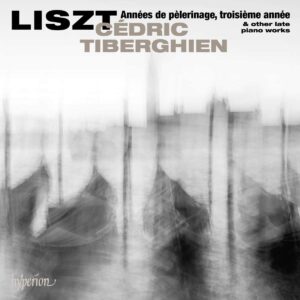Liszt’s later piano music is often stark, lean, angular, and lacking in artifice, seemingly pointing the way toward Busoni and Bartók. For this reason, the third book of the Années de pèlerinage is anti-climactic in relation to the dramatic and virtuosic variety characterizing its two predecessors. Cédric Tiberghien plays these pieces for what they are, and sustains interest by gauging the dynamics so that the climaxes are distinct and meaningful. As a result, the two selections inspired by the Villa d’Este cypress trees seem less episodic and static than usual, while the arpeggio sprays throughout Les jeux d’eaux à la Villa d’Este emerge as alluringly muted watercolors, in contrast to Claudio Arrau’s ecstatic oceanic waves.
Tiberghien’s highly profiled phrasing of the Fourth Mephisto Waltz’s double octaves nearly draws attention away from the pianist’s staggeringly precise execution. While his elegant, understated shaping of the Bagatelle sans tonalité lacks Alfred Brendel’s acerbic bite and harmonic point, similar interpretive precepts suit En rêve, a piece that can sound mawkish in the wrong hands. I also like Tiberghien’s clear and transparent delivery of Schlaflos! Frage und Antwort’s rumbling, Schumann-esque left-hand writing. The pianist makes a special point to thank Yamaha for providing an instrument he considers to be one of the best pianos that he’s ever played on, although I don’t really warm to the glassy, overly bright timbre in the upper octaves. Jeremy Nicholas’ annotations provide a colorful, succinct, and extremely informative guide to the music.
































